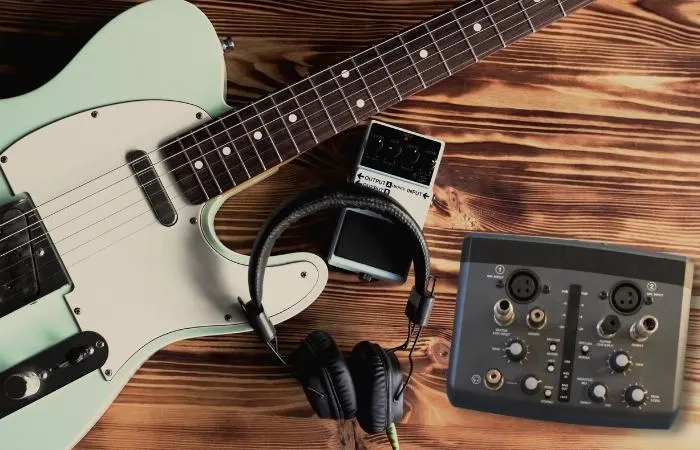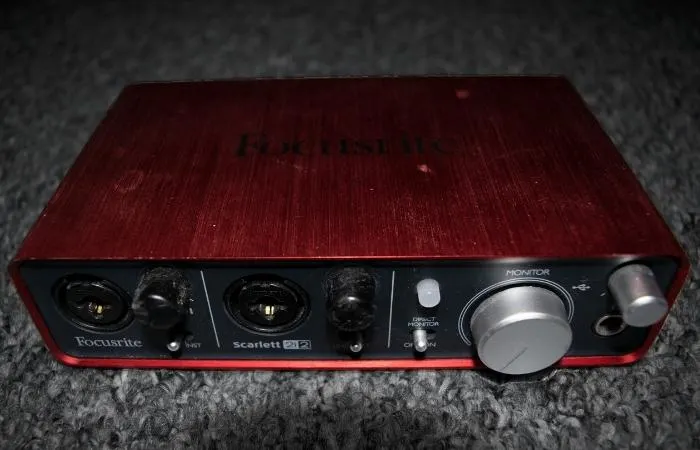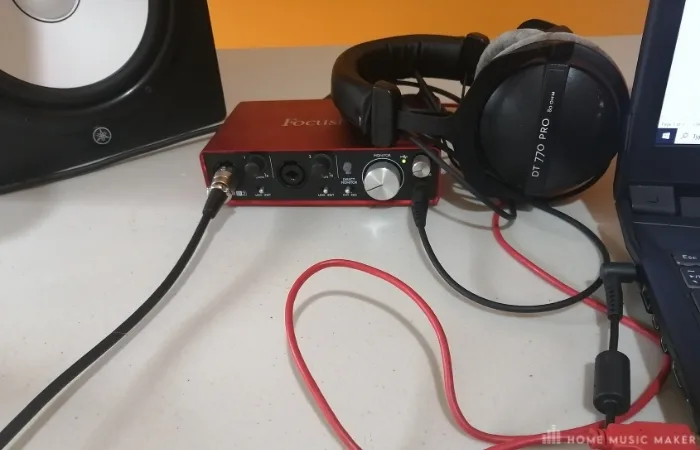KEY TAKEAWAYS:
A DI box, also called a direct box, helps balance the sound when recording specific instruments. It’s suitable for instruments like guitar or bass that have high-impedance output. This means it can make the sound better when it goes into a recording device like the Scarlett.
But, if you use instruments with an active pickup or low-impedance output, you don’t need a DI box because the sound is already balanced. And if you use an amplifier, you don’t need a DI box.
DI Boxes
A DI box is a unique tool that helps balance the sound when recording specific instruments. It’s helpful when using a guitar or bass with a high-impedance output.
This means it can make the sound better when it goes into the recording device. If you’re new to recording, you may not need a DI box.
But suppose you’re using instruments with active pickups or low-impedance output. In that case, you don’t need a DI box because the sound is already balanced.
Also, if you’re using an amplifier, you don’t need a DI box either. It’s a helpful tool to use when you’re making your own recordings.
What Is A DI Box?
To understand Direct boxes, we first need to understand something called impedance.
According to Wikipedia, electrical impedance is “the ratio of the voltage phasor to the electric current phasor, a measure of the opposition to time-varying electric current in an electric circuit.“

Impedance is vital in audio systems because it affects how much power and sound goes through the equipment. If the impedance levels do not match, the sound and power will not be good, and the equipment can get damaged.
A DI box helps match the levels when connecting a guitar to a mixer or audio equipment. It connects a low-impedance signal to high-impedance equipment.
It is often used when the signal from the mic or instrument is too weak to be amplified by the mixer or other equipment.
Do You Need A DI Box For Your Guitar Going Into A Focusrite Scarlett?
A DI box may be helpful when recording a guitar with a passive pickup.
It is also helpful with a high-impedance output with a Focusrite Scarlett. It helps make the sound stronger and matches the levels between the guitar and Scarlett.

And it helps you get a better recording.
Using a DI box might be a good idea if you need to improve the sound quality of your recordings.
A DI box can also help reduce signal loss over long cables. But, if you are recording a guitar with an active pickup or through a guitar amp, a DI box may not be necessary.
READ NEXT:
If you’re a guitarist, then you should check out our article on whether you need an audio interface to record guitar.
What Focusrite Scarlett Models Require A DI Box?
Using a DI box with all Focusrite Scarlett models is not necessary. Whether a DI box is essential for your Focusrite Scarlett setup depends on your recording setup’s specific needs. Such as the instrument and the recording method.

Suppose you are recording an instrument with a high-impedance output, passive pickup, or long cable. In that case, a DI box may be necessary. It will match the levels between the instrument and the recording device. And reduce signal loss.
Do You Need A DI Box With An Audio Interface?
As with a Focusrite Scarlett setup, whether you need a DI box with your audio interface will depend on your specific recording needs.
A DI box may be necessary for recording a high-impedance instrument or using a passive pickup. It will match the levels between the instrument and the audio interface. And reduce signal loss.
But, if you are recording an active pickup instrument or using an amplifier, a DI box may not be necessary.
Should You Use DI for Recording If Your Interface Has Instrument-Level Inputs?
Instrument-level inputs on an audio interface accept signals from instruments. Such as guitars or bass, without the need for a DI box.
But suppose you are recording an instrument with a high-impedance output or passive pickup. In that case, a DI box may be necessary. It will boost the signal strength and match the instrument and recording device levels.
If you are recording an instrument with an active pickup or low-impedance output, or if you are recording through an amplifier or preamp, a DI box may not be necessary.
Audio Interface Vs. DI Box (What Are The Key Differences?)
An audio interface is a device that connects to a computer and allows you to record and playback audio. It has inputs for instruments, microphones, and line-level sources. As well as outputs for monitors and headphones.
A DI box is a device that converts an unbalanced, high-impedance instrument-level signal into a balanced, low-impedance microphone-level signal.
It connects an instrument directly to a recording device or mixing console without an amplifier.
One key difference between an audio interface and a DI box is the type of signals they can handle. Audio interfaces handle various signal types, including instrument-level, microphone-level, and line-level signals.
DI boxes handle instrument-level signals and convert them to a level suitable for recording.
Another difference is the purpose of the devices. Audio interfaces are for recording and playing back audio.
DI boxes are for connecting instruments to recording devices or mixing consoles.
Is It Worth Getting A DI Box, Or Should You Use An Audio Interface?
Again, this will depend on the specific needs of your recording setup.

Suppose you are recording an instrument with a high-impedance output, passive pickup, or long cable. In that case, a DI box may be beneficial. It will match the levels between the instrument and the recording device. And reduce signal loss. In these situations, a DI box can be a valuable tool in your recording setup.
If you are recording an instrument with an active pickup or low-impedance output, or if you are recording through an amplifier, a DI box will do you a little good. An audio interface may be enough for your recording needs in these situations.
It’s essential to consider the specific needs of your recording setup and choose the equipment that will best meet those needs.
Why You Should Consider Using A DI Box
When recording an instrument with low impedance, there are several reasons why you should consider using a DI box in your recording setup.
Proper level matching: This will ensure that the instrument’s signal is strong enough to be correctly recorded and won’t be lost in the noise floor.
Long cables: If you run a long cable from an instrument to the recording device or mixing console, a DI box can help reduce signal loss. Long cables can introduce noise and hum, so a DI box can help isolate the instrument’s signal and keep it clean.
Live recording: If you are recording an instrument with a high-impedance output in a live setting, a DI box can help match the levels between the instrument and the mixing console.
Like the first point, this will ensure that the instrument’s signal is strong enough to be mixed appropriately. It won’t be lost in the noise floor.
How To Use DI Box With An Audio Interface
Using a DI box with an audio interface is simple. Here’s how to do it:
- Connect the instrument to the DI box using an instrument cable.
- Connect the DI box to the audio interface using a balanced cable.
- Set the input on the audio interface to the appropriate channel for the DI box.
- Set the output on the DI box to the proper channel for the audio interface.
- Adjust the levels on the audio interface and DI box as needed.
- Begin recording or playing back audio through the audio interface as desired.
It’s important to note that some audio interfaces may have built-in DI functionality. In this case, you may not need an external DI box.
Suppose your audio interface does not have built-in DI functionality, or you use a passive pickup instrument. In that case, an external DI box can be valuable in your recording setup.
It’s also worth mentioning that some DI boxes have more features. Such as grounding lift switches, ground loop isolation, and pad switches. Which can be helpful in certain recording situations.
Be sure to familiarize yourself with the features of your DI box and how to enhance your recordings.
READ NEXT:
A common issue with recording is eliminating unwanted noise. For a simple guide on this, check out our article on fixing Focusrite static noise.
Related Questions
Does A Mic Need A DI Box?
A microphone does not need a DI (direct injection) box. A DI box is a device that connects a microphone or other instrument-level signal to a piece of professional audio equipment.
It is often used when the signal from the microphone or instrument is too weak. Or when the signal needs to be balanced (converted from an unbalanced to a balanced signal).
Sometimes, a DI box may be helpful or even necessary. Such as when connecting a microphone to a mixer that does not have a microphone input. Or when connecting a keyboard or other instrument to a mixer or recording device.
Yet, a DI box is often unnecessary, and a microphone can be connected directly to a mixer or other audio equipment using a microphone cable.
Can You Use An Interface As A DI Box?
You’re in luck if you want to use your audio interface as a DI box! Connect your microphone or another instrument to the interface’s instrument-level input. The interface will then convert the signal to a line-level signal that your computer or another device can use.
Be aware that not all audio interfaces have instrument-level inputs. You should check the specs of your particular interface to make sure it’s possible. And suppose you find that the signal from your mic or instrument is too weak to adequately amplify. In that case, some audio interfaces also have built-in preamps. These can boost the signal before it’s converted.
This can be a valuable feature to have in your recording setup.
Do You Need ASIO With Focusrite?
Regarding audio recording, ASIO drivers can be a real lifesaver, especially when using a Focusrite audio interface.
The ASIO driver with your Focusrite interface will be fine if you use a DAW like Pro Tools or Ableton. It will help you achieve minimal latency. And let you record and playback audio like a pro. It’s beneficial when you’re working with live instruments.
But if you’re looking to listen to music or watch videos, you don’t need to bother with ASIO. Your computer’s built-in audio driver should work fine.
Be sure to check the manufacturer’s website. See if your specific Focusrite model has a compatible driver. Make sure it is for your operating system and DAW software. Trust me; you want to avoid running into hiccups during your recording sessions!
Do You Need A DI Box If You Have A Mixer?
It depends on what you’re trying to accomplish with your recording setup.
If you’re recording a guitar with a passive pickup or high-impedance output, then using a DI box can be helpful.
It’ll help boost the signal strength and adequately match the instrument and mixer levels, resulting in a more polished and professional-sounding recording.
But if you’re jamming with friends and don’t mind a bit of extra noise, or you’re using instruments that don’t require a DI box, you might not need one. Ultimately, it’s all about getting the sound that you want!
Final Words
To wrap things up, a DI box can be a handy piece of equipment in your recording toolkit. It’s beneficial for recording instruments with high-impedance outputs. Or passive pickups or long cables. It helps balance the levels between the instrument and the recording device.
And if you’re performing live, a DI box can also help match the levels between your instrument and the mixing console.
Remember that you may not need a DI box if you’re recording an instrument with an active pickup or low-impedance output or using an amplifier.
Ultimately, it’s all about considering the unique needs of your recording setup and choosing the equipment that’ll help you achieve the best results.
READ NEXT:
Of course, a DI box and audio interface are only part of what you can use for music production. For a more in-depth look, check out our article on building a home studio on a budget.

 Want to connect with other music producers for help and guidance?
Want to connect with other music producers for help and guidance?